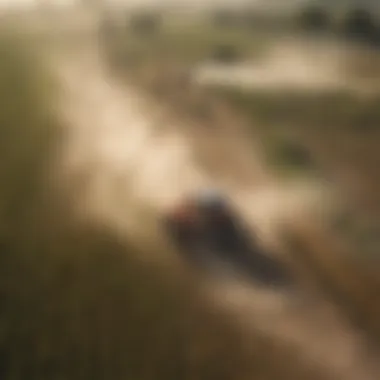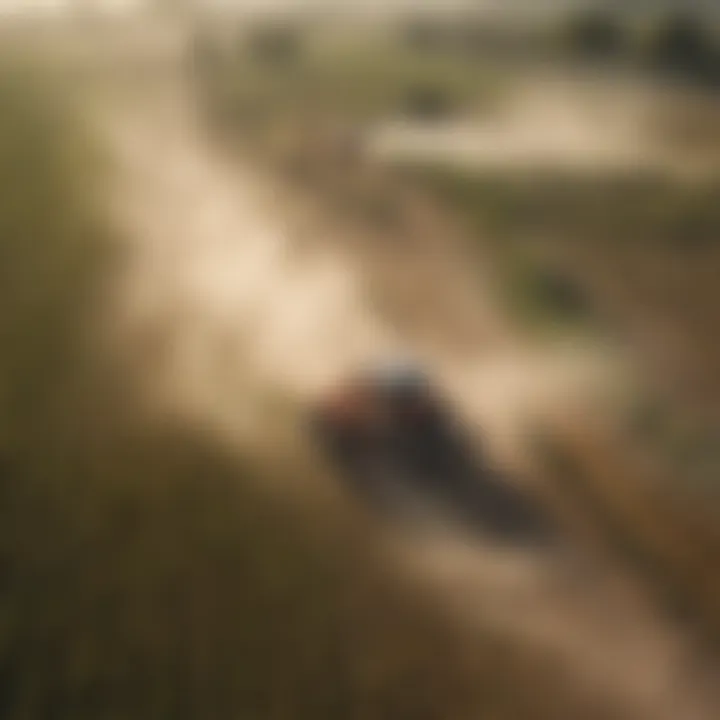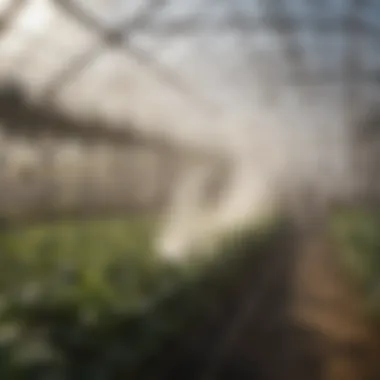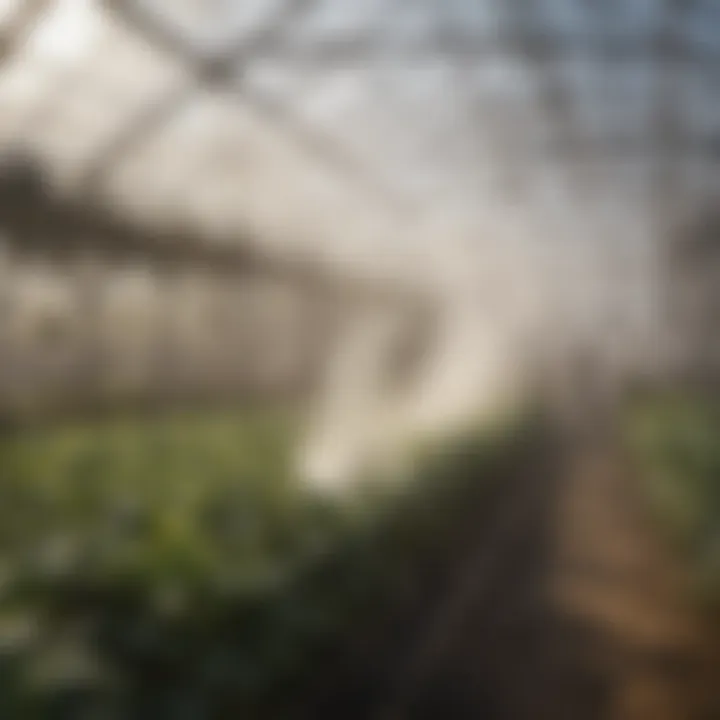Fogging and Misting Techniques in Agriculture


Overview of the Topic
Fogging and misting are crucial techniques in modern agriculture. They help to optimize the growing conditions for crops while managing pests and diseases effectively. These methods are especially relevant today due to the need for sustainable practices in farming. Farmers must adapt to a rapidly changing climate and consumer demands for better-quality produce. Understanding these techniques can lead to improved crop yields and reduced environmental impact.
Definition and Importance
Fogging involves generating a thick mist of fine droplets, typically using heated water or other solutions. This method can efficiently cover large areas with minimal water waste. Misting produces larger droplets compared to fogging, primarily targeting the immediate environment around plants. Both techniques serve vital purposes ranging from pest control to disease management and even irrigation. These methods are essential for enhancing productivity in various agricultural systems.
Current Trends
A growing trend in agriculture is the integration of smart technologies with fogging and misting systems. Many farmers now use automated systems that can adjust water usage based on weather conditions. This innovation helps to conserve resources and minimize chemical use. There is also a rise in the application of organic solutions in these systems, moving away from traditional chemicals to more eco-friendly options. As technology advances, we expect to see more efficient and tailored approaches to fogging and misting.
Key Techniques and Practices
Step-by-Step Guide
- Assessment of Needs: Evaluate the specific challenges on your farm, such as pest infestations or moisture deficiencies.
- Choosing a System: Decide whether fogging or misting suits your needs better based on your crops and environmental factors.
- Setting Up Equipment: Install foggers or misting systems according to product guidelines, ensuring even coverage across your fields.
- Monitoring Conditions: Regularly check weather patterns and soil moisture levels to optimize application schedules.
- Evaluating Results: Analyze crop performance and adjust your practices as necessary.
Tools and Equipment Needed
Essential tools for effectively applying fogging and misting include:
- Fogging machines, such as Thermal Foggers or Ultrasonic Foggers.
- Misting systems, including high-pressure misting pumps and nozzles.
- Water quality testing kits for natural sources, ensuring contaminant-free supply.
- Monitoring equipment for soil moisture and weather conditions to guide application timing.
Challenges and Solutions
Common Obstacles
Several challenges arise with fogging and misting. One major issue is the initial investment in equipment, which may deter some farmers. Additionally, ensuring uniform distribution of mist or fog can be difficult, leading to uneven application.
Innovative Solutions
To address these challenges, farmers can:
- Seek out government subsidies or collective purchasing options to reduce equipment costs.
- Utilize drone technology for precision fogging or misting applications, ensuring even distribution and efficient coverage.
By embracing innovation and technology, farmers can overcome the inherent challenges faced when implementing fogging and misting techniques in agriculture.
Through careful consideration of the benefits and challenges associated with fogging and misting, agricultural professionals can optimize their practices and contribute to sustainable farming.
Preamble to Fogging and Misting
Fogging and misting represent crucial techniques in modern agriculture, aiding in optimizing crop management while addressing pressing environmental challenges. These methods involve the application of water in fine droplets, effectively enhancing irrigation processes and facilitating pest control. Their significance in agricultural practices cannot be overstated. Understanding the principles and applications behind fogging and misting is essential for farmers and agricultural specialists committed to sustainability and productivity.
In the realm of agriculture, the efficient use of water becomes increasingly important with the realities of climate change and water scarcity. Fogging and misting systems provide a way to maintain moisture levels in crops without excessive water wastage. This leads to improved growth environments, while also reducing evaporation.
Defining Fogging and Misting
Fogging refers to the process of dispersing very fine water droplets into the atmosphere, creating a fog-like effect. This method is often used in greenhouses or controlled environments to increase humidity and regulate temperature. In contrast, misting involves the creation of larger droplets, mainly for cooling and irrigation purposes. Both techniques rely on specialized equipment to deliver the water effectively, with terms sometimes used interchangeably. The precision and control they offer make them advantageous for a variety of agricultural applications.
The Role in Agriculture
Fogging and misting systems serve multiple functions within the agricultural sector. Key roles include:
- Irrigation Enhancement: Both methods can be used to provide essential moisture to plants, significantly benefiting growth and yield.
- Pest Management: The dispersal of water can help reduce the prevalence of pests and diseases, therefore acting as a preventive measure.
- Temperature Regulation: Especially in greenhouses, these techniques can help moderate temperatures, thereby creating a more conducive environment for crop growth.
Adopting fogging and misting systems allows for a more controlled agricultural environment. Their versatility leads to better crop outcomes, improved resource management, and advancement towards more sustainable farming practices. As the agriculture industry continues to evolve, integrating these methodologies becomes paramount.
Mechanisms of Fogging and Misting
Understanding the mechanisms of fogging and misting is essential for agricultural practices aimed at enhanced efficiency and productivity. These methods rely on the physical principles governing the formation and distribution of tiny water droplets, which are critical for moisture application in various farming contexts. Knowing how these systems work helps farmers optimize their use, ensuring water is used effectively while also addressing pest control and environmental management.
Physics of Water Droplet Formation
The process of water droplet formation is governed by physical principles that dictate how water particles combine to form droplets. When water is dispersed through fogging or misting systems, pressure and temperature play pivotal roles. Water under high pressure is forced through nozzles that produce tiny droplets. These droplets can vary in size, typically ranging from 5 to 50 micrometers in diameter.
The mechanics of droplet formation involve atomization, where larger volumes of water are broken into smaller particles. Factors such as the nozzle design, pressure settings, and the viscosity of water affect the sizes of the droplets produced. This atomization is crucial; smaller droplets have a greater surface area relative to their volume, which enables quicker evaporation and better moisture distribution across crops.
Moreover, optimizing the environmental conditions—like humidity and wind—can maximize effectiveness. Water droplets in fog or mist can remain suspended in the air, allowing them to cover a larger area before evaporating. Understanding these mechanics aids farmers in controlling the precise application of moisture according to specific crop needs and local atmospheric conditions, thus improving water usage efficiency.


Equipment Used in Fogging and Misting
The choice of equipment influences the effectiveness of fogging or misting systems significantly. Various types of foggers and misters are available, each designed for specific applications and environments. Here are some common types:
- Thermal Foggers: These devices use heat to vaporize water, creating a fine mist. They are particularly effective in controlling pest populations, as the mist penetrates dense foliage effectively.
- Ultrasonic Foggers: These utilize ultrasonic vibrations to create tiny droplets. They are energy efficient and work well in indoor settings like greenhouses.
- Low-Pressure Misters: These systems operate at lower pressures and are suitable for large agricultural fields, dispersing water efficiently over wide areas.
Additionally, control systems and sensors have been integrated into many modern fogging and misting equipment. Automated systems can adjust droplet size, volume, and the timing of water application based on environmental feedback. This level of integration enhances precision and reduces resource waste.
Selecting the right equipment involves assessing factors like crop type, local climate, and the specific goals of the agricultural operation. A well-planned setup can lead to significant advantages in terms of yield and resource management.
"Optimizing fogging and misting techniques not only conserves water but also promotes healthier crops by ensuring precise moisture application."
Applications in Agriculture
In agriculture, the effective use of fogging and misting techniques plays a critical role in enhancing productivity and sustainability. These methods are not merely supplementary; they are integral to modern agricultural practices. Fogging and misting address specific needs such as water management, pest control, and the maintenance of optimal growing conditions. Understanding these applications allows farmers to maximize their yield while using resources more efficiently.
Fogging and misting are particularly vital when considering the varying water needs of different crops. Utilizing these methods can lead to precise irrigation management that aligns with the specific requirements of plants, unlike traditional methods that often result in over or under-watering. This precision is crucial as it conserves water resources and helps in maintaining soil health.
Crop Irrigation Techniques
Irrigation is one of the primary applications of fogging and misting technologies in agriculture. Through these techniques, farmers can ensure that crops receive the right amount of water. Fogging systems can create a fine mist which helps to cool the environment. This is particularly useful in hot climates where evaporation rates are high. Crops such as tomatoes, peppers, and lettuce benefit significantly from this method, as it maintains moisture without saturating the soil.
Key Benefits:
- Allows targeted watering, reducing waste.
- Helps in managing soil erosion by preventing runoff.
- Reduces the risk of fungal diseases by maintaining humidity at optimal levels.
Pest and Disease Management
Fogging is also an effective method for managing pests and diseases in crops. By using fogging equipment, farmers can disperse insecticides and fungicides in a way that maximizes coverage with minimal chemical use. This targeted application reduces the potential for resistance among pests, a growing concern in agriculture today. Additionally, misting can help create microclimates that deter pests.
Considerations for Pest Management:
- Timing of application is crucial to target pests at vulnerable stages.
- Weather conditions must be monitored, as wind can affect spray distribution.
- Farmers should be conscious of beneficial insects and avoid harming them inadvertently.
Greenhouse Environment Control
In greenhouse settings, misting and fogging systems are essential for controlling humidity and temperature. A controlled environment allows for year-round cultivation of delicate plants that would not survive outdoor conditions. By using fogging systems, greenhouses can maintain humidity levels conducive to plant growth while avoiding excess moisture that can lead to disease.
Benefits of Mist Control in Greenhouses:
- Promotes healthy plant growth by providing consistent moisture.
- Reduces energy costs associated with heating and cooling.
- Enhances the resilience of plants against heat stress.
"The use of fogging and misting systems in agriculture represents a shift toward more sustainable practices, optimizing resources while maximizing production."
As agriculture faces challenges from climate change and water scarcity, fogging and misting techniques will continue to evolve, offering solutions that align with modern farming needs. This application in agriculture highlights the necessity of adopting innovative practices that not only support human activity but also protect the environmental integrity.
Advantages of Fogging and Misting
Fogging and misting techniques are integral to modern agricultural practices. Their widespread use is attributed to a variety of advantages both for the farmers and for the crops they cultivate. Understanding these advantages helps highlight the value of incorporating fogging and misting into agricultural systems. In this section, we will delve into several key benefits that these methods provide.
Water Conservation
Water conservation is a major consideration for any agricultural practice. In many regions, water is a limited resource. Fogging and misting techniques utilize significantly less water compared to traditional irrigation systems. This is primarily because they deliver moisture directly into the air surrounding the plants, creating a micro-climate that reduces evaporation. This method ensures that moisture stays focused on the plant environment instead of being dispersed broadly into the soil.
The efficiency of fogging systems can result in a reduction of water usage by up to 50%. Through precise control over the amount of water released, farmers can customize the application based on real-time environmental conditions. Thus, adopting fogging methods can directly address the challenge of water scarcity, making it an essential practice for sustainable agriculture.
Energy Efficiency
Another significant benefit of fogging and misting is energy efficiency. These methods typically require less energy than conventional irrigation. Traditional systems often rely on pumps to move large volumes of water, consuming considerable amounts of electricity in the process. In contrast, fogging and misting systems work at a more localized level. They operate using smaller water droplets, which can be created with minimal energy consumption.
Additionally, these systems can improve the overall energy efficiency of environmental control in greenhouses. By regulating temperature and humidity through precise water management, farmers can create optimal growth conditions without excessive use of heating or cooling methods. This translates not only into reduced costs but also promotes a more eco-friendly approach to farming.
Improved Crop Yield
The potential for improved crop yield is perhaps the most appealing advantage of fogging and misting. These methods maintain a controlled growing environment, which is crucial for plant health. The micro-climate created by fogging can enhance plant growth by ensuring adequate moisture levels, thereby reducing plant stress. Healthy plants are likely to produce better yields.
Studies have shown that crops treated with misting or fogging systems often experience higher growth rates and increased fruit quality. This is particularly significant for sensitive crops that may struggle under traditional irrigation methods. With consistent and targeted watering, farmers can produce higher yields, leading to better profitability.
"By integrating fogging and misting, farmers are not just ensuring efficient resource usage, they are investing in the future of agricultural productivity and sustainability."


Challenges of Fogging and Misting
Fogging and misting are effective techniques in agriculture, but they come with various challenges that must be addressed for successful implementation. Understanding these challenges is essential for farmers and agricultural professionals. By evaluating and mitigating these issues, one can harness the full potential of these techniques while minimizing drawbacks. The following sections delve into three primary challenges: initial setup costs, maintenance requirements, and environmental considerations.
Initial Setup Costs
The initial investment for fogging and misting systems can be substantial. Costs vary significantly based on the type of system selected, the area to be covered, and the equipment's specifications. Fogging systems can range from simple sprayers to more complex automated setups. Investing in quality equipment is critical, as poor-quality systems may lead to efficiency losses and increased operational expenditures over time.
It's important to note that while the upfront costs may deter some, the long-term benefits can outweigh these expenses. Consider calculating potential return on investment (ROI) based on improved yields and reduced water usage over time. Many farmers find that with proper planning, the financial burden is manageable.
Maintenance Requirements
Maintenance is a crucial aspect of fogging and misting systems. Regular upkeep is necessary to ensure proper operation and longevity of the equipment. Neglecting maintenance can lead to inefficiencies, inconsistent misting patterns, and even equipment failure. Common maintenance tasks involve checking and replacing filters, unclogging nozzles, and ensuring that pumps function correctly.
Furthermore, farmers should schedule periodic inspections to identify wear and tear or any other potential issues early. By devoting time and resources to maintenance, farmers can avoid costly repairs in the future. This consistent attention to detail will enhance system performance and crop health.
Environmental Considerations
Environmental impact is an increasingly critical topic in agriculture. Fogging and misting systems can contribute both positively and negatively to local ecosystems. On one hand, these methods can improve water efficiency in irrigation and reduce the reliance on traditional, more harmful chemicals. However, on the other hand, they can introduce challenges. For example, fine water droplets can drift under windy conditions, potentially affecting nearby non-target crops or resulting in water wastage.
Additionally, the use of specific pesticides or nutrients in fogging solutions raises questions about chemical runoff and its effects on soil health and nearby water bodies. To address these concerns, best practices must be established, such as conducting thorough studies on potential impacts and choosing the right locations for implementation.
Ultimately, understanding these challenges helps in planning better strategies to utilize fogging and misting effectively while mitigating negative implications.
Are you ready to implement fogging and misting methods? Research is key, and assessing these hurdles will enable a sustainable approach.
Scientific Studies on Effectiveness
Scientific studies play a crucial role in understanding the effectiveness of fogging and misting techniques in agriculture. These methods are not just based on anecdotal evidence; instead, they require rigorous research to validate their benefits and address potential concerns. Proper studies help establish the conditions under which these systems operate best, leading to optimized results in crop management.
Research often encompasses various measures. These include evaluating the impact on crop yields, assessing water efficiency, and analyzing pest management effectiveness. Scientific investigations also consider environmental factors, helping farmers make informed decisions about the sustainability of fogging and misting practices.
By examining peer-reviewed studies, agricultural professionals can gauge the actual outcomes of these techniques. This clarity allows for evidence-based practices, moving beyond traditional methods that may not always yield the best results.
Research on Crop Outcomes
The relationship between fogging or misting and crop outcomes has been the subject of numerous studies. Results often indicate a positive correlation between the implementation of these practices and improvements in crop yields. For example, studies show that when crops are exposed to fogging systems, they experience better hydration and nutrient absorption. This is particularly significant in regions where traditional irrigation methods are insufficient due to water scarcity.
- Increased Yield: Many crops, such as tomatoes and lettuce, have shown substantial increases in yield when treated with misting techniques compared to standard irrigation.
- Quality of Produce: Enhanced moisture levels through fogging not only lead to higher yields but also significantly impact the quality of the produce, affecting size, firmness, and taste.
- Growth Rates: Scientific evaluations often highlight that crops can grow faster under optimal misting conditions, translating into shortened growing periods and quicker returns for farmers.
Ultimately, the insights drawn from these studies empower farmers to utilize fogging and misting strategically, maximizing their agricultural output.
Impact on Pest Infestation Rates
Pest management is another critical area where fogging and misting techniques have proven effectiveness. The scientific community has recognized that these methods not only improve crop health but also hinder pest proliferation.
Studies have documented reduced pest infestation rates in fields employing fogging systems. The most notable impacts include:
- Reduced Pesticide Use: By creating an environment less favorable for pests, fogging methods can lead to a decrease in chemical pesticide usage, promoting more sustainable farming practices.
- Pest Behavior Alteration: The increased humidity created by misting systems can disrupt pest life cycles, reducing both numbers and their activity.
- Enhanced Natural Predators: Certain misting practices can support the presence of beneficial insects that prey on harmful ones, leading to an effective natural pest control balance.
"Implementing a fogging system is like introducing an armor to the crops. It provides not only defense against pests but also shields plants against drought stress."
Technological Advancements in Fogging and Misting
Technological advancements have significantly transformed the fogging and misting practices in agriculture. These innovations have made the techniques more efficient, environmentally friendly, and easier to implement. Understanding these advancements is crucial as they directly impact productivity and sustainability for farmers and agricultural professionals.
Automated Systems
Automated systems in fogging and misting technology allow for precise application of water, nutrients, and pesticides. Automatic controls enable farmers to set specific schedules and durations for fogging or misting operations. This reduces labor costs and minimizes human error. Additionally, automated systems improve consistency in moisture application across various crop types. These systems often integrate various sensors that monitor environmental conditions. This data helps in making real-time adjustments, ensuring optimal performance every time.
- Key Benefits of Automated Systems:
- Reduces labor costs and manual effort.
- Enhances consistency in application.
- Provides real-time monitoring and adjustments.
Integration of these automated solutions can be a game changer in areas that face labor shortages. It also supports precision agriculture, where data-driven decisions can lead to enhanced crop yields.
Integration with IoT Solutions
The integration of Internet of Things (IoT) solutions into fogging and misting systems opens new doors for efficiency in agriculture. By connecting fogging equipment to the internet, farmers can remotely monitor and control their systems. IoT devices can track various environmental conditions such as temperature, humidity, and soil moisture. This real-time data collection provides insights that help in making informed decisions.


For instance, farmers can adjust misting schedules based on weather forecasts or detected soil moisture levels. The immediacy of this information allows for better resource management. Furthermore, data analytics tools can predict optimal fogging and misting operations based on past performance and environmental trends.
- Advantages of Integrating IoT:
- Remote monitoring and management capabilities.
- Enhanced decision-making based on real-time data.
- Predictive analytics for efficient operations.
"Technological advancements in fogging and misting are vital for sustainable agriculture as they ensure water conservation and improve crop health decisions collectively."
Best Practices for Implementation
Implementing effective fogging and misting systems in agriculture requires careful consideration. Best practices play a vital role in ensuring successful deployment, maximizing benefits, and minimizing potential pitfalls. These practices encompass several elements, including assessment, equipment selection, and ongoing monitoring. By adhering to these guidelines, farmers can optimize their use of these techniques and enhance overall productivity.
Site Assessment and Planning
Before installing a fogging or misting system, a detailed site assessment is essential. This involves evaluating the specific environmental conditions of the agricultural site. Farmers should consider factors like humidity levels, wind patterns, and proximity to water sources. These factors influence how droplets behave in the air, affecting their effectiveness in reaching crops.
One key benefit of thorough site assessment is the identification of potential obstacles. For instance, nearby structures or trees can impact airflow and subsequently the distribution of moisture. Planning should involve positioning the equipment thoughtfully, ensuring that mist reaches the intended targets without interference.
"A well-planned site assessment can lead to significant improvements in crop health and yield."
Additionally, consider the types of crops being cultivated. Different plants may have varying moisture needs which should be factored into the planning stage. Tailoring the fogging and misting approach to suit specific crop requirements can lead to better growth outcomes.
Choosing Appropriate Equipment
Once the site assessment is completed, the selection of suitable equipment becomes crucial. Farmers must evaluate the technological options available in fogging and misting systems. Various types exist, each with distinct features, capacities, and effectiveness. The choice should align with the specific needs of the farm and its crop types.
Factors to consider when choosing equipment include:
- Droplet Size: Smaller droplets can disperse better and cover more area, while larger droplets may provide more immediate moisture but can be less effective in wind.
- Pressure Levels: The system's pressure influences the droplet formation process, thus affecting coverage and efficiency.
- Automation: Automated systems offer ease of use and reduced labor costs, making them an attractive option for many farmers.
It's also wise to research the manufacturer's reputation and warranty options. Selecting reliable products helps ensure longevity and optimal performance of the fogging or misting systems in the long run.
Monitoring and Adjustment Techniques
After installation, maintaining an effective fogging or misting system requires continuous monitoring and adjustment. Farmers should regularly evaluate system performance against environmental conditions and crop health. Automated systems can facilitate this process, providing data that helps inform necessary changes.
Key monitoring techniques include:
- Evaluating Moisture Levels: Regular checks on soil and atmospheric moisture help determine if the system is delivering adequate irrigation.
- Observing Crop Response: Changes in plant health, such as wilting or growth rate, signal whether adjustments are necessary.
- Environmental Factors: Wind speed and direction may vary, affecting droplet distribution. Adjusting nozzle angles or flow rates based on these changes can enhance efficiency.
Farmers should also be prepared to make adjustments based on findings. Regularly modifying the system can lead to better performance and resource use.
Future Trends in Fogging and Misting
The discussion surrounding future trends in fogging and misting is crucial for agricultural professionals. As these methods evolve, understanding the innovations will help farmers and stakeholders optimize their practices. The ongoing shift towards sustainability and technological advancements will shape the agricultural landscape moving forward. It is essential to highlight several key areas where trends are emerging, as they offer significant benefits while addressing existing challenges.
Sustainability Initiatives
Recent years have seen an increasing focus on sustainability initiatives in agriculture. Fogging and misting play a role in this shift, as they promote efficient water use and reduced chemical application. These methods can minimize water wastage, providing an eco-friendly alternative for irrigation. Many farmers are now considering sustainable fogging systems, leveraging equipment that uses less energy and minimizes emissions.
Farmers are adopting techniques that align with environmental best practices, which are crucial for maintaining soil health and biodiversity. Sustainability initiatives often include:
- Using solar-powered misting units that reduce dependency on fossil fuels.
- Implementing rainwater collection systems to supplement fogging technology.
- Utilizing biodegradable pesticides in conjunction with misting systems to promote a healthier ecosystem.
By integrating fogging and misting into these sustainability initiatives, agricultural professionals can not only improve their practice but also contribute meaningfully to a greener future.
Continued Research and Development
Research and development remain pivotal in enhancing the effectiveness of fogging and misting in agriculture. Continuous advancements in technology lead to better equipment, allowing for finer mist control and increased droplet uniformity. This has implications for crop yield and disease management. As a result, organizations are investing in studies that focus on:
- The efficiency of new fogging systems.
- The long-term impacts of misting on crop health.
- The integration of fogging with smart farming practices.
Understanding how these systems can be improved is crucial for agricultural sustainability. Ongoing studies help validate the effectiveness of fogging and misting techniques. Additionally, the collaboration between institutions and agricultural businesses facilitates knowledge transfer regarding best practices. Recognizing the link between effective research and practical implementation is vital for the agricultural community.
"Innovation in fogging and misting technologies will drive forward the agricultural practices while addressing pressing environmental issues."
Finale
Summary of Key Points
In summary, several critical elements underscore the relevance of fogging and misting:
- Water Efficiency: Both techniques significantly reduce water wastage when compared to traditional irrigation methods.
- Enhanced Crop Resilience: The microclimate created can help plants better withstand pests and diseases.
- Technological Integration: Advanced systems utilize IoT for real-time monitoring, improving the effectiveness of these practices.
- Cost-Effectiveness: While initial set-up costs may be high, the long-term savings through increased yields and decreased resource use are compelling.
Final Thoughts on Adoption in Agriculture
Adopting fogging and misting systems requires careful consideration of various factors. Farmers must evaluate their unique operational needs, environmental conditions, and budget constraints before implementation. Investing in education and training on these technologies can further enhance their impact in the field. Ultimately, the adoption of these practices holds the potential to revolutionize agricultural methodologies, positioning farmers towards more sustainable and productive futures. As such, continuous engagement with research and technological advancements will be crucial in refining these techniques and fully realizing their benefits.



